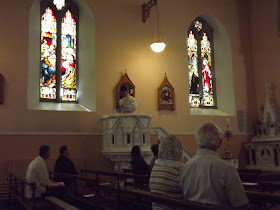
We have just received the following GLORIOUS news from the Institute of Christ the King in Ireland:
"
Sacred Heart Church purchased by the Institute of Christ the King in Limerick, Ireland
With the help of numerous friends from Ireland, the United States and Continental Europe, the Church of the Sacred Heart at the Crescent in Limerick, also known as the Jesuit Church after its first builders and long-term occupants, was recently purchased by a young priestly community called the Institute of Christ the King Sovereign Priest. The church and adjacent building, sold to a developer some years ago, had stood vacant for six years and was in danger of falling into ruin. Therefore many people from Limerick and other parts of Ireland were happy to help this Institute bring the Church of the Sacred Heart and its residence back to life.
A young community of members of the Institute of Christ the King will very soon move into the attached residence in spite of its rather poor condition, and the church will serve for the time being as its chapel. With the permission of the Bishop of Limerick, the Institute of Christ the King has had a residence in the diocese since 2009 and offers Mass every Sunday in the Extraordinary Form at St. Patrick's Church, whilst also working in a few neighbouring dioceses.
Founded in 1990, the Institute is a Roman-Catholic Society of Apostolic Life of Pontifical Right in canonical form. The 64 priests of the Institute work all over the world to promote the spiritual Kingship of Christ. A special emphasis is laid on the harmony between faith and culture, and thus the young community has acquired a reputation for promoting the arts, especially sacred music and architecture. This experience will serve to restore the Church of the Sacred Heart to its classical beauty and make it available once more as a point of reference for the cultural life of Limerick.
The mother-house and international seminary of the Institute of Christ the King is based in Florence, Italy, where 80 seminarians are training for the priesthood and 21 religious sisters are especially devoted to the Sacred Heart of Jesus. Among these are already several Irish vocations. This young community has missions in Gabon (Africa) and important apostolates in the United States, England, France, Spain, Belgium, Switzerland, Austria, Germany and Sweden and naturally in Rome, where their founder, Msgr. Gilles Wach, was ordained to the priesthood by Blessed Pope John Paul. The provincial superior of the community in Ireland is at present Msgr. Michael Schmitz, who was ordained a priest by the present Holy Father, the then Cardinal Ratzinger.
The prior of the Church of the Sacred Heart is a 38 year-old priest, Canon Wulfran Lebocq, choir-master of the Institute and permanently resident in the diocese since 2010. For the time being, the community in Limerick is composed of four members, whose average age is 32.
The Institute of Christ the King follows the spirituality of St. Francis de Sales, which is expressed in the motto of the Institute: Live the truth in charity, and could be summarised in the famous quote of the Doctor of Charity: Cook the truth in charity until it tastes sweet. The Canons of the Institute of Christ the King have a vast experience in working with the young. Schools, youth camps, days of recollection, musical training and many other activities are among the benefits they are used to bringing to the places where they work.
In Limerick, the Institute of Christ the King, supported by many local residents and a large group of friends in Ireland and abroad, intends to restore the Church of the Sacred Heart to its original purpose as a vibrant spiritual and cultural centre and a beautiful place of worship through a dynamic and open community life as a spiritual family. However, this will require a careful historical restoration before the Church may be opened once again to the greater public.
The Institute of Christ the King celebrates the classical Roman Liturgy, the Latin Mass, in its Extraordinary Form according to the liturgical books promulgated by Blessed Pope John XXIII in 1962. This liturgy, promoted by Blessed John Paul II and Pope Benedict XVI in various documents, attracts today an ever greater number of people, especially young adults, students and families. The Institute is accustomed to see a lively family of faithful in its churches and wishes to bring the uplifting beauty of sacrality and genuine culture to all.
This beautiful church at the Crescent is still today a special architectural jewel, and many deplored its closing and long-term vacancy. The Institute of Christ the King, which has a special devotion to the Sacred Heart of Jesus, truly desires to reopen this church for the benefit of all, in close collaboration with the local civil and ecclesiastical authorities. In this way, yet another sign of a brighter future will again come alive in Limerick.
Those who would like to know more about this important project for Limerick City can find further information either on their website (www.institute-christ-king.ie) or by visiting the community at the Crescent: Come and see!"
Ireland owes a great debt to the Institute of Christ the King for rescuing this Church from secular use (see
here and
here). A history of the Church can be found
here and some images of the Church can be found
here.
We say: REJOICE! REJOICE! REJOICE!









































